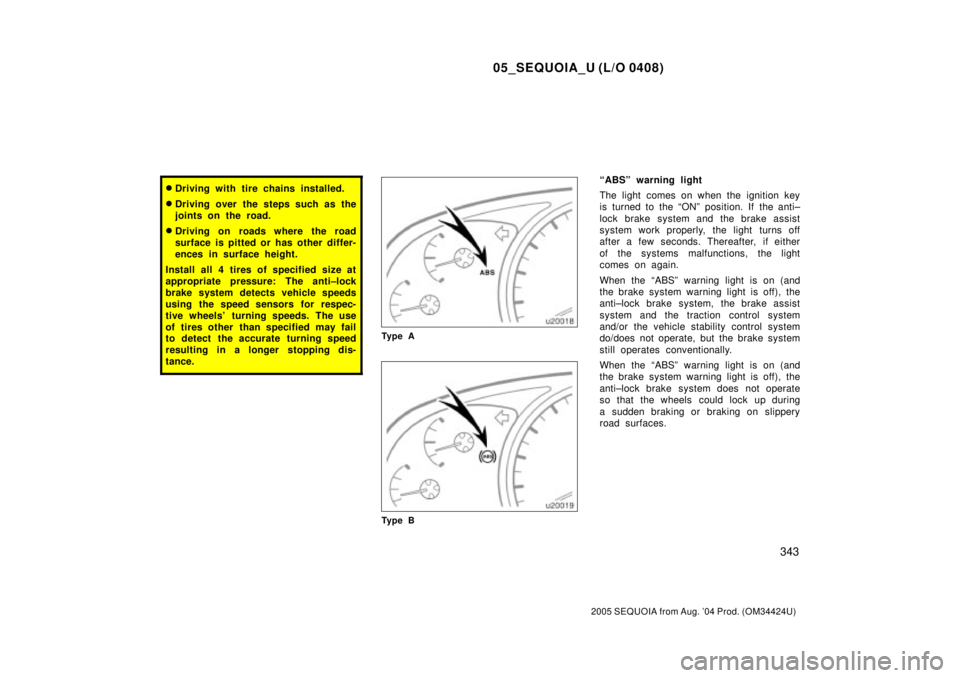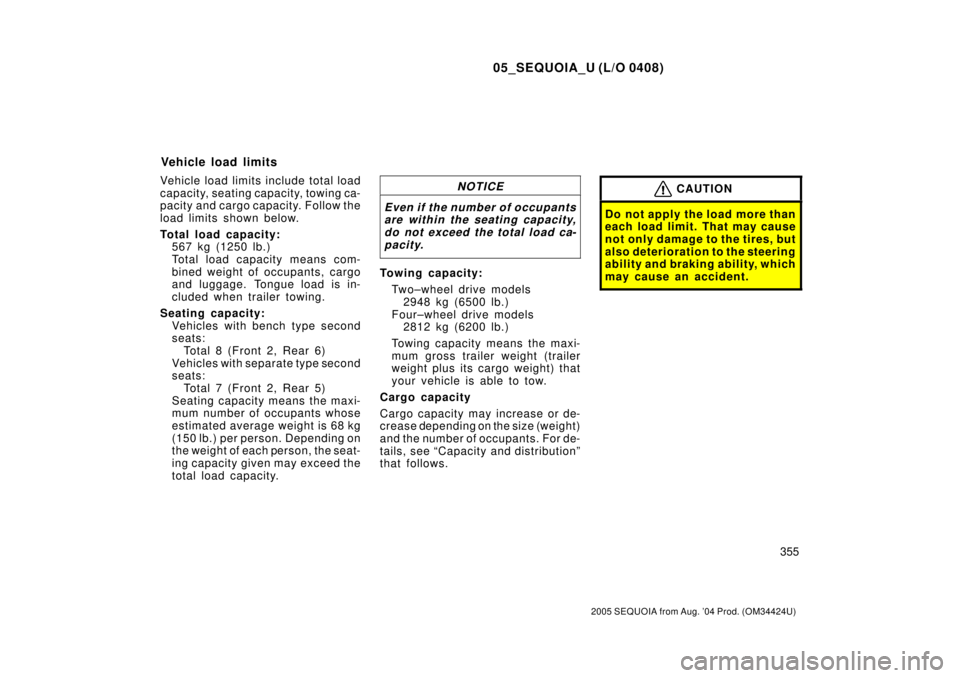Page 4202 of 4323

05_SEQUOIA_U (L/O 0408)
343
2005 SEQUOIA from Aug. '04 Prod. (OM34424U)
�Driving with tire chains installed.
�Driving over the steps such as the
joints on the road.
�Driving on roads where the road
surface is pitted or has other differ-
ences in surface height.
Install all 4 tires of specified size at
appropriate pressure: The anti±lock
brake system detects vehicle speeds
using the speed sensors for respec-
tive wheels' turning speeds. The use
of tires other than specified may fail
to detect the accurate turning speed
resulting in a longer stopping dis-
tance.
Ty p e A
Ty p e B
ªABSº warning light
The light comes on when the ignition key
is turned to the ªONº position. If the anti±
lock brake system and the brake assist
system work properly, the light turns off
after a few seconds. Thereafter, if either
of the systems malfunctions, the light
comes on again.
When the ªABSº warning light is on (and
the brake system warning light is off), the
anti±lock brake system, the brake assist
system and the traction control system
and/or the vehicle stability control system
do/does not operate, but the brake system
still operates conventionally.
When the ªABSº warning light is on (and
the brake system warning light is off), the
anti±lock brake system does not operate
so that the wheels could lock up during
a sudden braking or braking on slippery
road surfaces.
Page 4208 of 4323
05_SEQUOIA_U (L/O 0408)
349
2005 SEQUOIA from Aug. '04 Prod. (OM34424U)
This illustration indicates typical tire
size.
1. Tire use (P=Passenger car,
T=Temporary use)
2. Section width (in millimeters)
3. Aspect ratio (tire height to section
width)
4. Tire construction code (R=Radial,
D=Diagonal)
5. Wheel diameter (in inches)
6. Load index (2 digits or 3 digits)
7. Speed symbol (alphabet with one
letter)1. Section width
2. Tire height
3. Wheel diameter1. Bead
2. Sidewall
3. Shoulder
4. Tread
5. Belt
6. Inner liner
7. Reinforcing rubber
8. Carcass
9. Rim lines
10.Bead wires
11. Chafer
ÐTire size ÐName of each section of tire
Page 4210 of 4323

05_SEQUOIA_U (L/O 0408)
351
2005 SEQUOIA from Aug. '04 Prod. (OM34424U)
Temperature A, B, CÐT he tem per a-
ture grades are A (the highest), B,
and C, representing the tire's resis-
tance to the generation of heat and
its ability to dissipate heat when
tested under controlled conditions on
a specified indoor laboratory test
wheel. Sustained high temperature
can cause the material of the tire to
degenerate and reduce tire life, and
excessive temperature can lead to
sudden tire failure. The grade C cor-
responds to a level of performance
which all passenger car tires must
meet under the Federal Motor Vehicle
Safety Standard No.109. Grades B
and A represent higher levels of per-
formance on the laboratory test wheel
than the minimum required by law.
Warning: The temperature grades for
this tire are established for a tire that
is properly inflated and not over-
loaded. Excessive speed, underinfla-
tion, or excessive loading, either sep-
arately or in combination, can cause
heat buildup and possible tire failure.
Page 4212 of 4323

05_SEQUOIA_U (L/O 0408)
353
2005 SEQUOIA from Aug. '04 Prod. (OM34424U)
Ti r e relat ed ter mMeaning
Normal occupant weight68 kg (150 lb.) times the number of occupants specified in the second
column of Table 1 that follows
Occupant distributiondistribution of occupants in a vehicle as specified in the third column of Table
1 that follows
Production options weight
the combined weight of those installed regular production options weighing
over 2.3 kg (5 lb.) in excess of those standard items which they replace,
not previously considered in curb weight or accessory weight, including
heavy duty brakes, ride levelers, roof rack, heavy duty battery, and special
trim
Recommended inflation pressurecold tire inflation pressure recommended by a manufacturer
Rima metal support for a tire or a tire and tube assembly upon which the tire beads
are seated
Rim diameter (Wheel diameter)nominal diameter of the bead seat
Rim size designationrim diameter and width
Rim type designationthe industry of manufacturer 's designation for a rim by style or code
Rim widthnominal distance between rim flanges
Vehicle capacity weight
(Total load capacity)the rated cargo and luggage load plus 68 kg (150 lb.) times the vehicle's desig-
nated seating capacity
Vehicle maximum load on the tirethe load on an individual tire that is determined by distributing to each axle
its share of the maximum loaded vehicle weight and dividing by two
Page 4214 of 4323

05_SEQUOIA_U (L/O 0408)
355
2005 SEQUOIA from Aug. '04 Prod. (OM34424U)
Vehicle load limits include total load
capacity, seating capacity, towing ca-
pacity and cargo capacity. Follow the
load limits shown below.
Total load capacity:
567 kg (1250 lb.)
Total load capacity means com-
bined weight of occupants, cargo
and luggage. Tongue load is in-
cluded when trailer towing.
Seating capacity:
Vehicles with bench type second
seats:
Total 8 (Front 2, Rear 6)
Vehicles with separate type second
seats:
Total 7 (Front 2, Rear 5)
Seating capacity means the maxi-
mum number of occupants whose
estimated average weight is 68 kg
(150 lb.) per person. Depending on
the weight of each person, the seat-
ing capacity given may exceed the
total load capacity.NOTICE
Even if the number of occupants
are within the seating capacity,
do not exceed the total load ca-
pacity.
Towing capacity:
Two±wheel drive models
2948 kg (6500 lb.)
Four±wheel drive models
2812 kg (6200 lb.)
Towing capacity means the maxi-
mum gross trailer weight (trailer
weight plus its cargo weight) that
your vehicle is able to tow.
Cargo capacity
Cargo capacity may increase or de-
crease depending on the size (weight)
and the number of occupants. For de-
tails, see ªCapacity and distributionº
that follows.
CAUTION
Do not apply the load more than
each load limit. That may cause
not only damage to the tires, but
also deterioration to the steering
ability and braking ability, which
may cause an accident.
Veh icle lo ad limit s
Page 4218 of 4323
05_SEQUOIA_U (L/O 0408)
359
2005 SEQUOIA from Aug. '04 Prod. (OM34424U)
All season tires, however, do not have
adequate traction performance
compared with snow tires in heavy or
loose snow. Also, all season tires fall
short in acceleration and handling
performance compared with summer
tires in highway driving.
The details about how to distinguish
summer tires from all season tires are
described on page 347.
CAUTION
�Do not mix summer and all sea-
son tires on your vehicle as
this can cause dangerous han-
dling characteristics, resulting
in loss of control.
�Do not use tire other than the
manufacturer's designated
tires, and never mix tires or
wheels of the sizes different
from the originals.
Page 4221 of 4323

05_SEQUOIA_U (L/O 0408)
362
2005 SEQUOIA from Aug. '04 Prod. (OM34424U)
1. Check the area around the vehicle be-
fore entering it.
2. Adjust seat position, seatback angle,
seat cushion angle, head restraint
height and steering wheel angle.
3. Adjust the inside and outside rear view
mirrors.
4. Lock all doors.
5. Fasten seat belts.Once you turn the ignition key to ªSTARTº
position and release it, the cranking hold
function continues to crank the engine in
ªONº position until it starts.
The function stops cranking the engine
after about 25 seconds maximum if the
engine has not started yet. When you
crank the engine again, wait a few sec-
onds and restart it.
If you hold the key in ªSTARTº position,
the function will keep cranking for about
30 seconds maximum.1. Apply the parking brake firmly.
2. Turn off unnecessary lights and acces-
sories.
3. Put the selector lever in ªPº. If you
need to restart the engine while the
vehicle is moving, put the selector le-
ver in ªNº. A starter safety device will
prevent the starter from operating if the
selector lever is in any drive position.
4. Depress the brake pedal and hold it to
the floor until driving off.
Before starting the engineHow to start the engineÐ
ÐCranking hold function(a) Before cranking
Page 4222 of 4323

05_SEQUOIA_U (L/O 0408)
363
2005 SEQUOIA from Aug. '04 Prod. (OM34424U)
Before starting the engine, be sure to fol-
low the instructions in ª(a) Before crank-
ingº.
Normal starting procedure
The multiport fuel injection system/sequen-
tial multiport fuel injection system in your
engine automatically controls the proper
air±fuel mixture for starting. You can start
a cold or hot engine as follows:
With your foot off the accelerator pedal,
turn the ignition key to ªSTARTº position,
then release it.
Engine should be warmed up by driving,
not in idle. For warming up, drive with
smoothly turning engine until engine cool-
ant temperature is within normal range.
If the engine stalls...
Simply restart it, using the correct proce-
dure given in normal starting.
If the engine will not start...
See ªIf your vehicle will not startº on page
382 in Section 4.NOTICE
�Do not race a cold engine.
�If the engine becomes difficult to
start or stalls frequently, have the
engine checked immediately.
�Always slow down in gusty crosswinds.
This will allow you much better control.
�Drive slowly onto curbs and, if pos-
sible, at a right angle. Avoid driving
onto high, sharp±edged objects and
other road hazards. Failure to do so
can lead to severe tire damage such
as a tire burst.
Drive slowly when passing over bumps
or travelling on a bumpy road. Other-
wise, the impact could cause severe
damage to the tires and/or wheels.
�When parking on a hill, turn the front
wheels until they touch the curb so
that the vehicle will not roll. Apply the
parking brake, and place the transmis-
sion in ªPº. If necessary, block the
wheels.
�Washing your vehicle or driving through
deep water may get the brakes wet. To
see whether they are wet, check that
there is no traffic near you, and then
press the pedal lightly. If you do not
feel a normal braking force, the brakes
are probably wet. To dry them, drive
the vehicle cautiously while lightly
pressing the brake pedal with the park-
ing brake applied. If they still do not
work safely, pull to the side of the road
and call a Toyota dealer for assistance.
(b) Starting the engineTips for driving in various
conditions